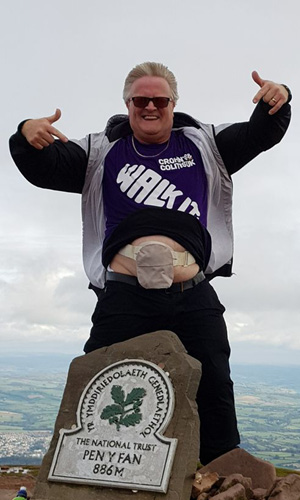My name is Keith, and I’m a bus driver from Wales. Work is very important to me, and I am happy that it is no longer the obstacle it used to be before my stoma was formed. In 2008, after many years of illness, I was diagnosed with ulcerative colitis. In 2012, my bowel finally gave up on me, and I had to have a total colectomy. In the lead-up to getting a stoma, my working life was already becoming increasingly difficult. Through my illness, I worked as a quality control inspector and then as a purchaser for a bus seat manufacturer. This was a very difficult time; I had one of the worse sickness records ever.
I would always try to get to work, but the colitis would make me soil myself on the way in. At that point, there were two options: shower and try again or just phone in sick. Unfortunately, it was usually easier to go for the latter. On those days, I felt so ill and depressed that I didn’t know if going back to work would ever be an option. However, once I got my stoma, I found out that it was.
Going back to work
 After my life-changing operation, it took only 6 weeks before I went back to work. I did have to be very careful not to lift anything too heavy so that I didn’t get a hernia. This is a serious possibility, as the opening made for the stoma leaves the stomach wall considerably weaker than before.
After my life-changing operation, it took only 6 weeks before I went back to work. I did have to be very careful not to lift anything too heavy so that I didn’t get a hernia. This is a serious possibility, as the opening made for the stoma leaves the stomach wall considerably weaker than before.
Although I was pleased to be back in work full-time, I was missing my previous life as a coach driver. I had enjoyed meeting so many new people and visiting new places for free. I had spent 10 very enjoyable years doing this, but I had to give up in 2004, partly because my illness was making it so difficult to do. Then, one day, I saw in the paper that the public transport company First Cymru was advertising for drivers. My decision to apply is one of the best I have ever made. During the hiring process, I was completely open and honest about my illness and operation, and I explained how my life had changed for the better since getting a stoma.
I now drive the bus for 40 hours a week, so having an ostomy has meant that I have been able to return to a normal life. It feels amazing: illness is a thing of the past. Realising that you came so close to losing your life really makes you appreciate it on a completely different level. My stoma is called Homer, and I want to tell whoever will listen that he saved my life. I want to show others that there is life after illness and that doing a full-time job is possible. In my line of work, I meet a lot of people, and I would say that about 90% of them know about my stoma. My colleagues and managers know I have a disability, albeit a hidden one, but they don’t treat me differently because of it.
Tips for going back to work after stoma formation
How long it takes before you can go back to work will depend on the severity of your disease and the reason for the operation, as well as your age and type of work. Generally, if you feel comfortable travelling to and from work, have enough energy and can change your pouch without assistance, you can return to work. Once you are ready to go back:
• Only do as much as you can—if your body is telling you to take a day off, do so
• Before going back to work, work out how many times a day you will need to change or empty your pouch
• Check out the toilet facilities at work before you need to use them
• Ostomates performing manual labour that requires a lot of bending and stretching should seek advice on how to protect their stoma, such as by wearing a stoma belt
• Where possible, it is useful to keep a change of clothes and all ostomy supplies at work
• If you’re worried about odours, stoma deodorants can be used to neutralise smells
Using the loo
I choose to use disabled toilets whenever possible, as they provide more room to empty my bag, but I have had no problem on occasions having to empty it in a train toilet or even on an aeroplane. Sometimes, people may be confrontational when they see you going into the disabled toilet when they cannot see that you have a disability. Being an ostomate just means having a different toilet routine, and it is up to the individual how they approach these challenges. Personally, I tackle it head on, explaining to people why I use the disabled toilets and, if necessary, showing them my ostomy bag. This approach works well for me.
It is safe to say that, 6 years after the operation, I have an amazing life. I know I am one of the lucky ones, having such a positive ostomy experience so far, and having experienced no problems or leaks worth mentioning. However, even with my experience, I was driving the hour-long route from Llanelli to Swansea, when I noticed a strong smell of poo in my driver’s cab. My first thought was that I had a leak in my pouch. Looking down at my shirt, I could see nothing, but the further I drove, the stronger the smell became. This was very confusing and a little worrying. When I reached my destination, the mystery was solved. A lady got off with her baby in a pushchair and exclaimed: ‘Sorry for the smell—he has filled his nappy’. What a relief that was.
Sharing experiences
After my operation, I decided to expand my social media presence and use it to share my experiences and offer advice and support to others. It took off and started to grow rapidly, mainly due to my Twitter account. This, in turn, led to a lot of other things: a few blogs, a swimwear photoshoot for ostomy wear, charity fundraising, guest speaking at an event for Respond Healthcare about my life after illness. I even managed to appear in a 2017 calender published by Stomawise. I take great pleasure in talking to other people about my ostomy, and, if it helps just one person to cope a little better, then job done. I am not a regular blogger; I have only done one or two blogs so far, but I have posted a few videos about my ostomy on my YouTube channel.
The Turdis
A range of new toilet facilities for bus drivers has been installed along routes though London. Dubbed ‘Turdises’ by opponents for their resemblance to the famous time-travelling device, the loos can be found in areas where no other toilet facilities are available. Although there are no plans to install Turdises outside London yet, Keith feels that the they would be welcome in Wales, as there can never be too many places to take a decent comfort break.
Staying positive
I make sure I exercise by walking a lot: I recently completed a year-long challenge, which involved walking 5 km once a week for 52 weeks. Not only did I complete the challenge in July 2018, but I also raised over £1300 for Crohn’s and Colitis UK.
When asked why I am so positive, considering what I have been through, I tell them that I have lost so many people to so many illnesses, but I am still alive and will not waste my life being negative. Please join me on my positive journey, as we have only one life, and we should make the most of it. Inflammatory bowel disease (IBD) is a horrible illness, which so many have to live with. I am glad to say that, from my experience, living with a stoma is not the horrific thing some people think it is, and I would choose it over IBD every time. Please feel free to contact me through my Twitter feed, and, if you want to ask me anything, I’m always here to help.
 Keith Thomas is a 57-year-old bus driver from Swansea, now living in Llanelli
Keith Thomas is a 57-year-old bus driver from Swansea, now living in Llanelli
The contents of this page are property of MA Healthcare and should not be reused without permission

